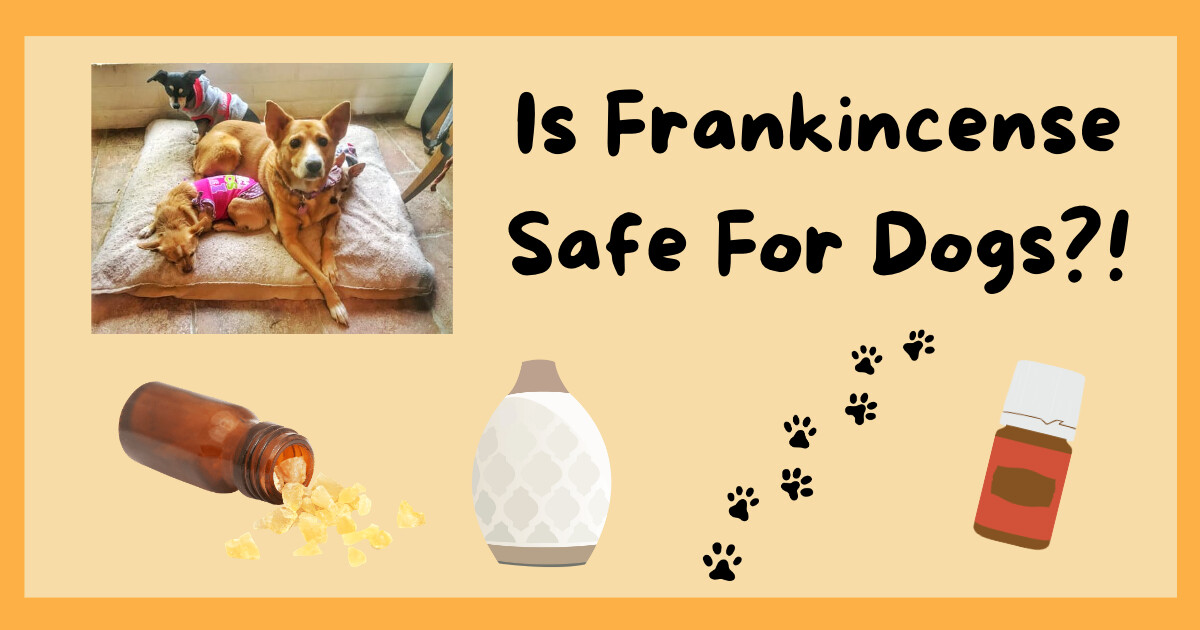
Frankincense is a natural product that has been used for centuries for its medicinal properties. But is it safe for dogs? In this post, let's take a look at the safety of frankincense oil for dogs, plus some tips on how to use it safely.
What Is Frankincense?
Frankincense is an aromatic resin that comes from the Boswellia tree. Frankincense essential oil is then extracted by steam distillation of the resin. Frankincense is noted as an incredibly beneficial natural remedy that has been used for thousands of years for a variety of purposes. Some of the touted benefits of frankincense oil include support for the immune system, cognitive health and respiratory health. It has also been used in religious ceremonies and as a natural fragrance in perfumes and cosmetics. There is also research on its effects on certain types of cancers. According to this study on PubMed.gov, "Frankincense, pine needle and geranium essential oils have been reported to play critical biological activities in cancer". This review published on PubMed.gov, states "Contemporary studies have shown that resin indeed has an analgesic, tranquilising and anti-bacterial effects." I have even seen frankincense on the ingredient list in natural pet flea products.
Is It Safe for Dogs?
Many natural pet care advocates believe that frankincense can be safely used to support a wide range of health concerns, as long as it is used in proper amounts and a pure, high-quality essential oil is used. Most experts agree that using frankincense essential oil is generally safe for dogs when a 100% pure and unadulterated essential oil is used and properly diluted.
I believe the two most important factors in safely using any essential oil with your pets is quality and dilution. I use Young Living™ Essential Oils-the world leader in essential oils. With their Seed To Seal guarantee, you know you're getting pure and premium products for you and your pets health!
If your dog has a pre-existing medical condition, you should speak to your holistic veterinarian before using frankincense oil or any essential oil on them. Again, it is of the utmost importance to make sure that any product you use contains pure essential oils and not adulterated additives or other chemicals. Also it's important to dig deep when googling 'oil poisoning' or 'are essential oils bad for dogs' and not let that scare you from using essential oils. Oftentimes, the whole story is lacking important facts such as quality of oil, amount, and the way it was used.
Tips for Using Frankincense Oil Safely with Your Dog
If you do choose to use frankincense oil with your dog, it is important to follow a few safety tips to ensure a positive outcome.
Start low and go slow. The easiest way to start using essential oils with your dog is by wearing them as a perfume and becoming a walking diffuser.
To do this, simply apply a drop of frankincense essential oil to the palm of your hand, rub your hands together, make a scent tent over your nose, inhale deeply, then apply the residue to the back of your neck or pulse points. Observe how your dog reacts to you! You are also half the equation with your dog and when you remain calm and balanced, that helps your dog remain calm and balanced!
Start using essential oils now, before you want to use them for a specific concern. Wearing them during play time or cuddle time helps your dog associate positive feelings with essential oils which adds to their benefits.
Dogs have an incredibly powerful sense of smell. Their noses are about 100,000 times more sensitive than that of a human, allowing them to detect odors that humans would miss. This is made possible by millions of olfactory receptors in their noses, which allow them to pick up even the faintest scents. Dogs also have specialized parts of the brain that are dedicated to processing these scented signals, and they can detect even subtle changes in odor that humans would miss. This is why it's often all that is needed to simply let your dog enjoy the aroma of an essential oil.
Once your dog is used to your new perfume, try running an essential oil diffuser. This is another favorite way to use essential oils! I like to use ultrasonic diffusers which use a metal or ceramic plate that vibrates and disperses the essential oil in a fine mist, keeping the oil at a low and safe concentration and allowing you to breathe in deeply and enjoy the scent and properties of the essential oils. Ultrasonic diffusers don't use heat which can lessen the benefits of an essential oil.
You can check out one of my favorite ultrasonic diffusers HERE!
When using a diffuser, be sure to start with a minimum number of drops like 2-4 and work up to more if needed or preferred. Always give your dog an out by leaving the door open. Keep in mind oftentimes our dogs prefer to stay with us even when uncomfortable, so watch for signs like restlessness, stupor, watery eyes, or itching.
Essential oils are made up of extremely small molecules, which means that they can easily penetrate the membranes in your nose and enter your bloodstream. The effects can be felt almost immediately after inhaling an essential oil. As you continue to breathe in this scent, it is absorbed by the olfactory bulb in your brain, which triggers certain chemical and electrical responses that can help to improve your mood and overall well-being. Our dogs can benefit in the same ways from inhaling an oil. Inhaling essential oils is one of the quickest ways to deliver the benefits that they have to offer. This method is perfect for you and your dog to enjoy natural ways to support health.
Frankincense pairs well with lavender oil, cedarwood, and vetiver, which are generally regarded as safe essential oils.
You can diffuse frankincense on its own or try one of these essential oil blends:
Be Calm
2 Drops Lavender Essential Oil
2 Drops Frankincense Essential Oil
Be Balanced
2 Drops Cedarwood Essential Oil
2 Drops Frankincense Essential Oil
Harmony
2 Drops Vetiver Essential Oil
2 Drops Frankincense Essential Oil
Topical application
When using frankincense essential oil topically with a dog, it is important to dilute the oil in a carrier oil such as coconut or olive oil. I prefer fractionated coconut oil, which is simply coconut oil processed to remain liquid and have no aroma. It's less greasy and absorbs well. This will help prevent skin irritation and allows for smaller amounts of essential oils to be used. Fore more info on carrier oils, click HERE
For my recommended dilution guide for essential oils and dogs, click HERE!
Frankincense can be helpful in supporting skin and overall wellness in your dog. It is much better to use a very small amount more frequently than a large amount infrequently.
Once you dilute the frankincense oil, you can apply with your fingertips and gently massage the area of concern. This oil blend works to help soothe skin:
Skin Love
Add 3 drops Frankincense and 3 drops of Myrrh essential oil to a 10 ml roller bottle. Then fill the remainder of the bottle up with a carrier oil. Gently invert back and forth to mix, and apply to areas of concern as needed.
If you are looking for a natural way to support your dog's health and well-being, using dog friendly essential oils like frankincense can have its benefits. When using frankincense topically or inhaling it, it is important to be 'oil safe' and use a 100% pure and unadulterated oil with proper dilution methods. With proper use, frankincense can be an effective and safe way to support your dog's health and well-being. To grab a bottle of Frankincense essential oil, click HERE!
It is also best to consult with a holistic veterinarian before using essential oils, as each dog will respond differently and a holistic veterinarian will look at the whole picture as essential oils can be effective, but they are often only a piece of the puzzle.
Essential oils can be a safe option for pet health. To eliminate overwhelm and fear and learn more about how to use essential oils with your dog, download my free guide "Getting Started Using Essential Oils With Your Dog" HERE
*Statements have not been evaluated by the FDA and the information in this blog is not meant to provide medical advice nor be a substitute for veterinary care.*
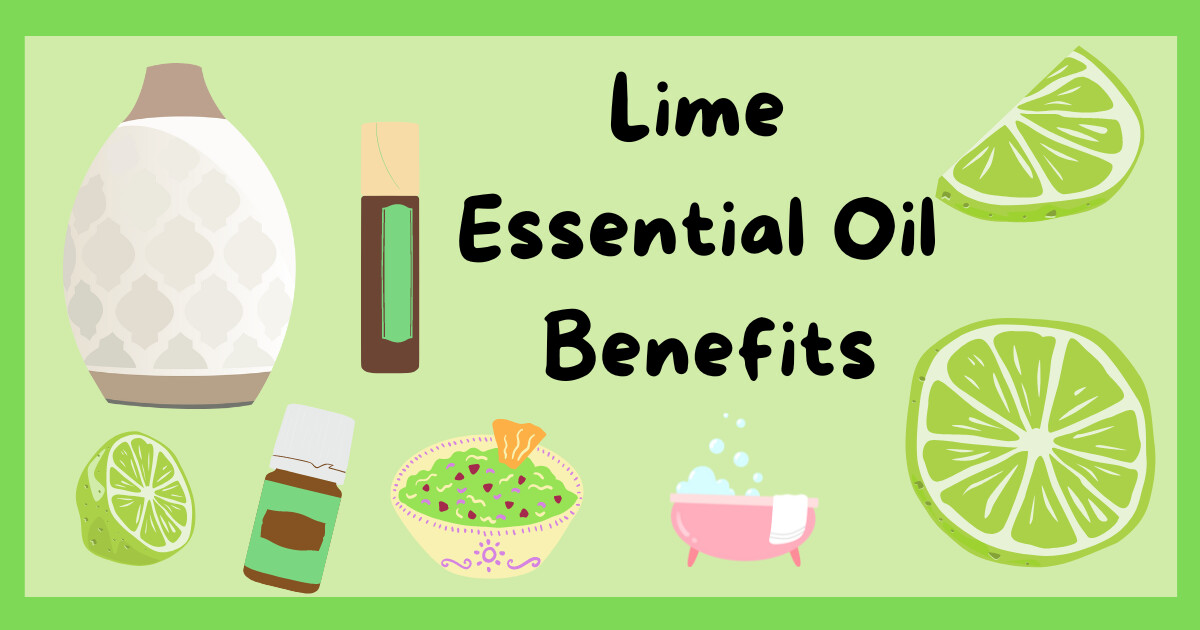
Limes have a long history of use for health, most notably for scurvy in the 18th and 19th century due to their high vitamin C content. Did you know that Lime essential oil (Citrus aurantifolia), derived from the lime fruit, also contains antioxidants and can benefit the body in many ways? Lime oil is also a popular ingredient in cosmetics, skincare products, and also used as a flavoring agent in food and beverages.
Lime is a citrus fruit that is related to the lemon. There are several varieties of lime but it is most commonly a hybrid of citron and pummelo. The lime fruit is green or yellow, and the juice is sour. Lime essential oil is usually extracted from the peel of the fruit by cold pressing.
Lime aroma is a citrusy, tart smell, that is refreshing, uplifting, and calming, all at the same time! In aromatherapy, its scent is often used to invigorate the mind, enhance focus, uplift the spirit, and improve mood.
How does lime essential oil benefit the body?
The properties of this versatile essential oil can benefit our health in many ways. I have used lime essential oil to:
- Promote a positive mood with limes uplifting and happy aroma
- As an air freshener and for odor control
- Scent cleaning products and personal care products
- In my skin care routine for its skin cleansing properties
- For my hair health
- For general health benefits and immune system support as it may contain antioxidants
- As a flavor boost in any food recipe that calls for lime
Did you know lime essential oil has been studied for its antioxidant capacity? This study summarizes that "Lime Essential Oil exhibits potent DPPH and ABTS free radical scavenging activity" This can make lime essential good for general wellness support.
Lime essential oil has also been studied "as a natural antimicrobial preservative" in food.
How to use lime essential oil
Lime essential oil can be used in a variety of ways – it can be added to skincare products, diffused in a aromatherapy diffuser, or applied topically with a carrier oil, or added to food recipes for antioxidant health benefits. Next time you reach for a bottle of lime juice or zest, consider the benefits of using lime essential oil as well. Your body – and your taste buds – will thank you.
Is lime essential oil safe for skin?
Yes, but take care with topical application of lime. As a citrus essential oil, lime oil should not be applied to skin that is exposed to sunlight, as it can cause phototoxicity, which means it can increase your skins sensitivity to sunlight. If applying during the day, apply underneath clothing or add to your personal care products at night before bedtime. I have used lime essential oil in my natural shampoo at night by simply adding a drop to the dollop I squeeze out in my palm. This gives me an 'all night diffuser aroma' coming straight from my hair! This also works well by adding a drop to your natural body wash.
You can also use the aroma of lime to relax at the end of the day and rejuvenate your body with a lime bath! Simply add about 5 drops of lime essential oil to 2 tablespoons of Epsom salts and dissolve in your bath water. The Epsom salts help to disperse the lime in the bath water.
When using lime essential oil topically, it is important to mix it with a carrier oil before applying directly to the skin. My favorite carrier oil is fractionated coconut oil, which is simply coconut oil processed to stay liquid and have no odor. It's light, absorbs well, and is non greasy. You can use any carrier oil you like though, such as jojoba oil, sweet almond oil, or grapeseed oil. You can also add a few drops of lime essential oil to your favorite all natural lotion, moisturizer, shampoo, and conditioner.
One of my favorite ways to use lime essential oil is by diffusing it in an essential oil diffuser. Diffusing essential oils can be a great way to unwind after a long day, promote better sleep, and purify the air. In fact, many people find that using a diffuser is one of the best ways to enjoy the benefits of essential oils.
When used in a diffuser, the aroma of lime essential oil can help to uplift the mood and create a sense of happiness. Lime essential oil is also known for its ability to promote creativity and clarity of thought, making it a great choice for use during meditation or prayer. Additionally, when used in aromatherapy, lime essential oil can be helpful in restoring balance and harmony to the body, mind, and spirit.
Essential oil diffusers are devices that disperse essential oils into the air. Diffusers come in a variety of shapes and sizes, but all work to release essential oils into the air. For help picking the right diffuser for you, check out my dedicated blog HERE.
Try some of my favorite lime oil blends below or make your own! Lime oil blends well with other citrus oils, lavender, neroli, and rosemary. I often interchange lime oil with other citrus essential oils in a blend if I don't have the particular essential oil the recipe calls for. Lime aroma will add an element of happiness to any blend!
Lovely Lime Time
3 drops lime
2 drops clary sage
1 drop vanilla
June Delight
2 drops lime
2 drops kunzea
2 drops citronella
Citrus Burst
2 drops lime
2 drops lemon
2 drops grapefruit
For even more lime essential oil diffuser blends, click HERE and
grab my free PDF of lime essential oil diffuser recipes!
Lime also makes a great flavor enhancer to food recipes! It will enhance the lime flavor of any dish that calls for lime. (Make sure you are using an essential oil labeled for ingestion, though, like Young Living's Vitality™ Lime, check it out HERE) I love to add a few drops to homemade guacamole and I love this "margarita popcorn" recipe!
1/4 cup coconut oil melted
5 drops Lime
salt to taste
Add the essential oil to the melted coconut oil, stir well, then drizzle over popped popcorn, and sprinkle with salt to taste. Yum!!
Lime essential oil has a host of benefits for the body, mind, and spirit. It's a great choice when you need an uplifting aroma or want to restore balance and harmony to the body, mind, and spirit.
If you already have lime essential oil, add it to your diffuser today! If not, consider adding lime to your wellness product line by shopping HERE. (This is an affiliate link and I earn a small commission from your order at no cost to you. Thanks for supporting my small business! I'm so excited to help you get started, that I'll connect with you once you order and send you something special!)
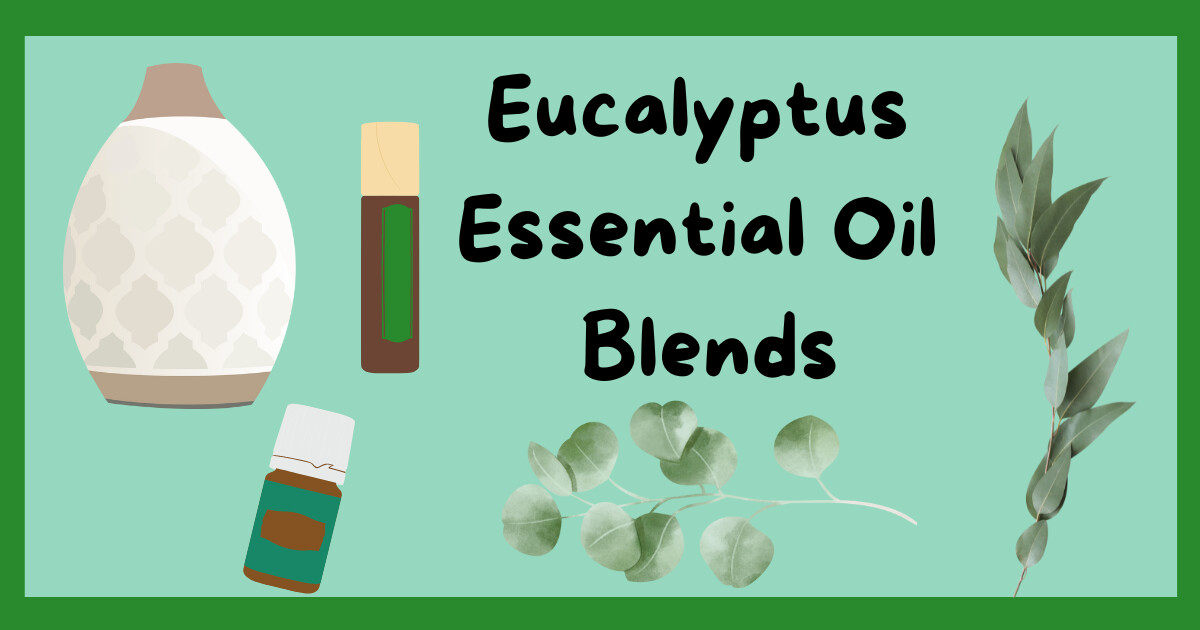
Are you already loving essential oils and looking for an invigorating and refreshing essential oil to add to your collection? Or perhaps you're new to essential oils and are looking for an oil blend that can help refresh your breathing or help with some odor control in your home? Then you'll want to take a look at eucalyptus essential oil! Its fresh, earthy, and crisp scent can make it a perfect choice to add to a diffuser blend for diffusing throughout the day in your home or workspace! Trouble with muscle tension? Rubbing an oil blend with eucalyptus essential oil into areas of need can do wonders!
Did you know that eucalyptus essential oil originally comes from Australia? Native to the country, the tree is commonly known as the "gum tree" or "blue gum tree." In fact, it's estimated that over 700 species of eucalyptus exist in Australia. Australian aborigines used eucalyptus leaves to bind wounds and prevent infection and speed healing, as well as for purification and to dispel negative energy. Thanks to its abundance and popularity, Australia is the largest producer and exporter of eucalyptus essential oil in the world. So next time you enjoy its refreshing scent, give a little nod to our friends Down Under!
Not all of those species of eucalyptus trees are distilled and used for essential oils, though. The 3 types of eucalyptus essential oil available from the company I love and use ( Young Living™,
the world leader in essential oils. With their Seed To Seal guarantee, you know you're getting pure and premium products for your health! Click HERE to check them out!) are:
- Eucalyptus radiata essential oil, also known as narrow-leaved peppermint eucalyptus, has a more subtle and sweet scent compared to other eucalyptus varieties like blue or globulus. It's often preferred for use in aromatherapy because it is noted as a milder form of eucalyptus.
- Eucalyptus blue essential oil, also known as blue gum eucalyptus, has a strong and sharper scent. If I'm looking for a clear mind, I love to diffuse this one!
- Eucalyptus globulus, or "common eucalyptus," has a bolder, more intense scent and is often used in cleaning products and industrial settings. I love to add about 5 drops of this one to my mop water!
I use all three varieties interchangeably, however eucalyptus globulous and eucalyptus radiata are less expensive than eucalyptus blue. Pick the one that you like the aroma of best and see what happens!
Eucalyptus essential oil is popular in aromatherapy for good reason! It has been studied for its effect on breathing and congestion. According to this review on PubMed.org “Eucalyptus oil (EO) and its major component, 1,8-cineole, have antimicrobial effects against many bacteria,” and this review reports “1,8-cineole is a natural monoterpene, also known as eucalyptol. It is a major compound of many plant essential oils, mainly extracted from Eucalyptus globulus oil. As an isolated compound, 1,8-cineole is known for its mucolytic and spasmolytic action on the respiratory tract, with proven clinical efficacy. 1,8-cineole has also shown therapeutic benefits in inflammatory airway diseases, such as asthma and chronic obstructive pulmonary disease (COPD). “
Other eucalyptus essential oil benefits include:
- muscle and bone support
- air freshener
- helps with pests
An easy way to see benefits to your breathing, head and muscle tension, or focus, is by adding eucalyptus to your diffuser. Try these easy diffuser recipes with eucalyptus:
For a refreshing breathing experience, add this blend to your aromatherapy diffuser!
Breathe Easy
2 DROPS EUCALYPTUS
2 DROPS LEMON
2 DROPS PEPPERMINT
This eucalyptus blend can help give you an energy boost throughout the day. Diffuse anytime you need a pick me up!
Energize Me
2 DROPS ORANGE
2 DROPS LEMONGRASS
2 DROPS EUCALYPTUS
Try this eucalyptus and lemon oil blend that works well for clearing the mind and promoting focus!
Targeted Focus
3 DROPS LEMON
3 DROPS EUCALYPTUS
Add some Vetiver to balance and calm. This is one of my favorite Eucalyptus recipes to make in a roller ball and wear as a perfume when I'm working with my horses! It helps them remain calm and focused on me making for a great training session! Simply triple the recipe, add to a 10 ml roller bottle, and then fill up the remainder of the bottle with a carrier oil like fractionated coconut oil. For a step by step guide to making a roller bottle, click HERE
Calm Focus
2 DROPS LEMON
2 DROPS EUCALYPTUS
2 DROPS VETIVER
This Lavender and eucalyptus oil blend recipe will help keep you calm and refreshed at the same time! Lavender and eucalyptus oil blend benefits can also help you to navigate through distraction. I've also used this roll on as well as a focus blend for my pony who oftentimes has 'squirrel syndrome'. I rub some on my hand and let him inhale deeply for as long as he wants, then apply the leftovers to his poll before a training session. It really helps him dive in and pay attention!
Calm And Fresh
2 DROPS LAVENDER
2 DROPS EUCALYPTUS
2 DROPS VETIVER
Eliminate unwanted odors and bring the garden in with this diffuser blend.
Flower Power
3 DROPS EUCALYPTUS
2 DROPS GERANIUM
1 DROP VANILLA
This eucalyptus and lemon oil blend is one of my favorites for odor control! Anytime your house needs a refresh on aroma, diffuse this!
Clean And Fresh
2 DROPS EUCALYPTUS
2 DROPS CINNAMON
2 DROPS LEMON
No time to hit the spa? Try this blend to bring the spa to you!
Spa Time
2 DROPS EUCALYPTUS
2 DROPS PATCHOULI
2 DROPS BERGAMOT
This oil blend is perfect for the porch, especially on warm summer nights!
Annoyance Away
2 DROPS EUCALYPTUS
2 DROPS CITRONELLA
2 DROPS KUNZEA
Download a PDF of these oil recipes so they're handy in your home. Click HERE
I have a couple of oil blends straight from Young Living™, that I love!
This blend is perfect to start off your morning routine!
Sun Salutation
4 DROPS EUCALYPTUS GLOBULOUS
2 DROPS SPEARMINT
2 DROPS VALOR™
Or try this blend for a refreshing energy burst!
Footloose And Fancy Free
3 DROPS CITRONELLA
2 DROPS EUCALYPTUS RADIATA
2 DROPS SPEARMINT
2 DROPS BLUE CYPRESS
If you want to have fun creating your own blends, eucalyptus also pairs well with pine, blue tansy, rosemary, and spearmint essential oils. Happy diffusing!
And don't worry - eucalyptus is also safe to use topically when diluted properly with a carrier oil
(for more info on carrier oils, click HERE). I love to make a roller bottle and rub on my chest for a natural breathing rub. Give this roller bottle a try and replace that popular, but not as healthy, vapor rub on the market!
Breathe Easy
10 drops eucalyptus essential oil
5 drops peppermint essential oil
Add to a 10 ml roller bottle, fill up with a carrier oil (like fractionated coconut oil) and rub on chest as needed. This blend works well for one of my older horses who has an occasional cough. I simply roll on his chest and rub in, in the mornin' and evening, for some respiratory support.
This recipe works well for muscle or head tension.
Muscle Rub
10 drops eucalyptus essential oil
5 drops peppermint essential oil
5 Drops Copaiba essential oil
5 drops lavender essential oil
fractionated coconut oil ( or add some extra strength to this by using Ortho Ease™ Massage Oil from Young Living™)
Add essential oils to a 10 ml roller bottle, and then fill up the remainder of the bottle with the carrier oil or Ortho Ease™. Rub on desired area and massage in. For head tension, rub behind the ears and on the back of your neck.
I hope you enjoyed reading about eucalyptus essential oil. Eucalyptus is an amazing oil with many applications - from diffusing to respiratory health to muscle tension to focus. I've shared over 8 of my favorite eucalyptus essential oil recipes with you today, but there are endless possibilities for what you can create. Be sure to grab the pdf download of the recipes HERE , so that you can have them on hand. If you have any favorite uses or benefits of eucalyptus oil, please share in the comments!
If ya don't have Eucalyptus essential and would like to purchase, simply click HERE. (This is an affiliate link and I earn a small commission from your order at no cost to you. I put all three in this bundle so you can check them out and pick the one that calls to you most..or try all three! Thanks for supporting my small business! I'm so excited to help you get started, that I'll connect with you once you order and send you something special!)
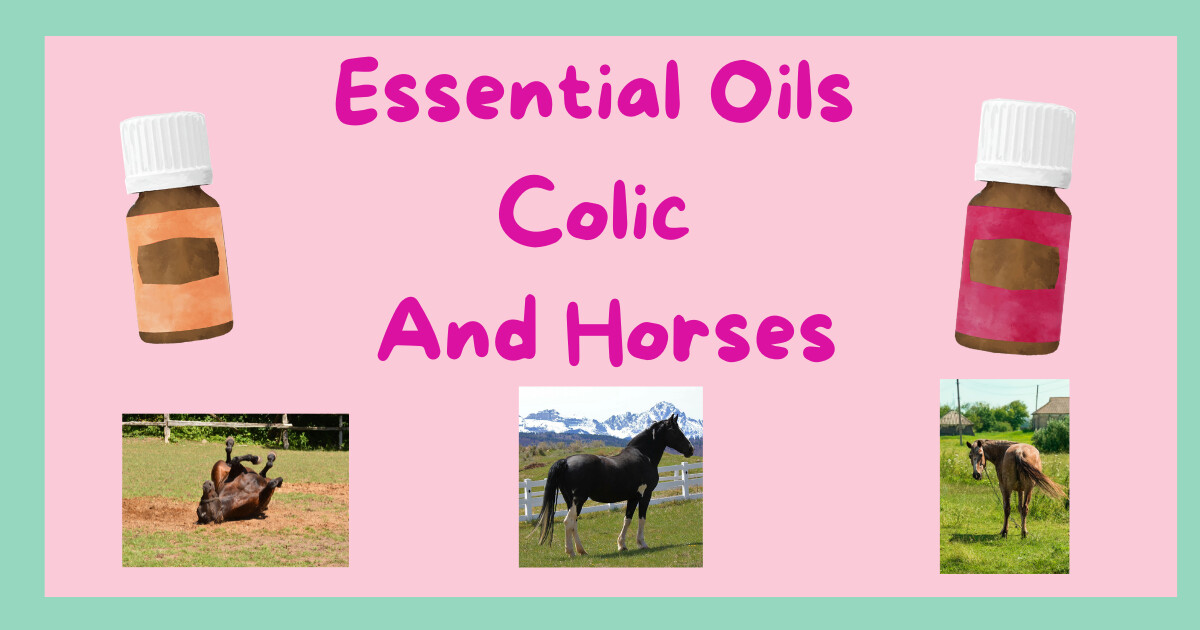
If you have a horse, or two like me, you've probably heard of colic. You may have even experienced this scary condition! I think, next to laminitis, it's one of the scariest health situations horse owners can face. Sometimes it can be mild, but oftentimes, it can turn life threatening very quickly. We want all the tools in our toolbox that we can possible cram in-right?! Did you know one of those tools is essential oils?!
In a nutshell, essential oils are super concentrated plant extracts. They are known for a variety of health benefits including emotional benefits like relaxation and promoting calmness. Let's chat what essential oils I keep on hand to use when the dreaded colic strikes!
What is colic in horses and what are the symptoms
In case you haven't heard of colic....lucky you! it's a general term used to describe clinical symptoms for digestive conditions, associated with abdominal pain, that can range from mild to life-threatening. Colic can be caused by many different things, such as gas, impaction, twisted gut, and more. If you suspect your horse has colic, call your veterinarian right away! Conditions of colic in your horse can become life threatening in a short amount of time, so I can't stress enough, your first course of action should be to call your veterinarian! The purpose of this article is not to give you a substitute for veterinary care, rather tools you can use to help support the situation, while you are waiting for your veterinarian!
The symptoms of colic can vary depending on the severity and cause of the pain. However, some common symptoms include restlessness, pawing at the ground, sweating, rolling, and looking or biting at their sides. If you notice any of these symptoms in your horse, call your veterinarian right away. Then grab your essential oils!
How to use essential oils to support a horse with colic
If you suspect your horse has colic, again, the first thing you should do is call your veterinarian. While you are waiting for your veterinarian to arrive, you can use essential oils.
There are hundreds of different essential oils in the marketplace today...which ones do you choose to support your horse? ! I have 3 must haves-2 essential oils and 1 blend of essential oils that I always keep on hand.
By the way, if ya wanna go ahead and grab these essential oils so you have them at the ready, simply click HERE and it’ll take ya to my specially curated bundle of these oils from the world leader in essential oils-Young Living™. With their Seed To Seal guarantee, you know you're getting pure and premium products for your health! (This is an affiliate link and I earn a small commission from your order at no cost to you. Thanks for supporting my small business! I'm so excited to help you get started, that I'll connect with you once you order and send you something special)
DiGize™ ( a blend for Young Living™ Essential oils containing Tarragon, Ginger, Peppermint, Juniper, Fennel, Lemongrass, Anise, and Patchouli)
Lavender is used to help calm and relax your horse. Studies have shown an increase in relaxation after a horse inhales the aroma of Lavender. If you don't have Lavender, you can substitute it for any essential oil you think might help to calm you and your horse.
Other calming essential oils I like to have on hand are: (To read more about my top calming essential oils for your horse and how to use them click HERE)
Valor™ ( a blend for Young Living™ Essential oils containing Frankincense, Black Spruce, Blue Tansy, Camphor Wood, and Geranium)
For best results, add a few drops of the essential oil to the palm of your hand, rub your hands together, inhale deeply and then allow your horse to inhale the aroma from your hands. Then apply the leftovers on the back of your neck and/or your horses poll. Lavender is a very mild essential oil and since you are applying the 'leftovers', I generally don't bother to dilute it when applying in this way. If you haven't used essential oils with your horse before, or your horse has sensitive skin, consider grabbing a dollop of a carrier oil like coconut oil first, to dilute.
Next offer your horse the aroma of Peppermint essential oil. You can offer them a whiff from the bottle or in the same way you offered the Lavender. Peppermint essential oil is very strong and can cause a tingling sensation on the skin, so if you'd like to try applying it, its best to grab a dollop of coconut oil and dilute before application. Then you can rub on the abdomen.
Take great care in that some horses will act aggressive when touched in a painful area, even if they have never acted in such a way before. Do not put yourself in harms way by trying to rub essential oils on your horses belly! Essential oils are made up of tiny volatile molecules that pass thru the olfactory receptors and into the limbic area of the brain rather quickly by inhalation, so it is not required to put them on topically for them to have a positive effect. If you don't have Peppermint essential oil, you can swap out for Spearmint or Ginger essential oil.
You may already notice a difference with your horse! If not, consider applying DiGize™ to your horses belly. It is best to dilute this blend by grabbing a dollop of coconut oil (you can use any carrier oil you have-like olive oil)( for more info on carrier oils, click HERE)in the palm of your hand, adding a several drops of DiGize™, rub your hands together to mix, and then rub on the abdomen, again taking care to be safe. You can also rub the diluted mixture on your horses gums in addition to the belly rub or instead of. If you dont have DiGize™, you can do this with diluted Peppermint essential oil as well. Or, if you have any of the single essential oils that are found in Digize™, you can try those.
For the most success in using essential oils with your horse, it's best to grab some and start using them now, before you have an urgent situation! If you'd like to learn how to use essential oils with your horse quickly, easily, and safely, check out my mini course "Oily Horse Intro" where we dive into the what, where, how, and why, of getting started using essential oils with your horse! Check it out HERE!
Thanks for reading my guide on how to use essential oils to support your horse when colic occurs. Remember, I am not a veterinarian nor do I prescribe, treat or diagnose, and essential oils are not a replacement for veterinary care! I simply have more peace of mind knowing that when the inevitable occurs, I have more tools in my toolbox for the situation, that can make a difference in the comfort of my horse.
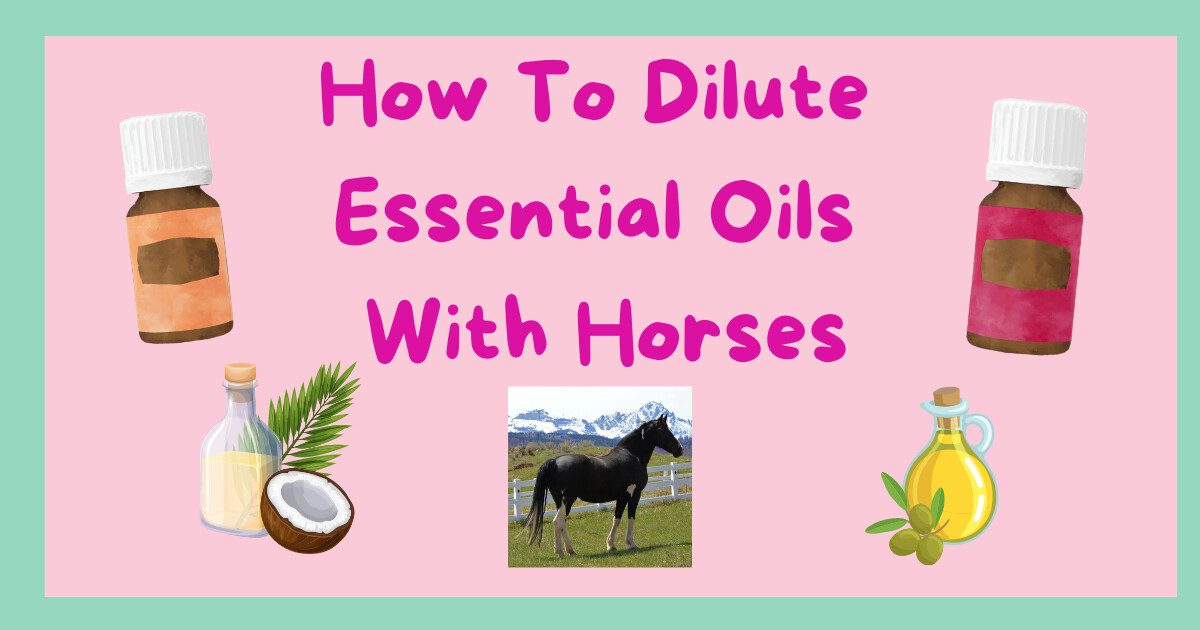
Essential oils come in handy with horse care! They are a great way to help keep your horse healthy and happy, and replace toxic chemicals at the barn. We can enjoy essential oils with our horses aromatically by smelling them, topically by applying them, or, if we have an essential oil labeled for ingestion, we can choose to use them as a supplement.
There are numerous benefits to using essential oils topically, but we want to do that in a safe and effective way. In this article, I'll walk you through diluting essential oils for topical use, so you can get the most out of using your essential oils on your horse, in a safe and effective way.
Essential oils can offer a variety of benefits for horses when applied topically. They can be used to help with a shiny mane and coat and for skin care. The can be helpful for outdoor annoyances that gather on and bother your horse. They can help to support the digestive system, breathing, and to promote calmness and relaxation. They come in quite handy in replacing hoof products, especially ones that you have to wear gloves to apply, with a healthier alternative.
Keep in mind that not all essential oils are created equally. You'll want to choose a high quality premium essential oil to use with your horse. I purchase and use essential oils from the world leader in essential oils-Young Living™. With their Seed To Seal guarantee, you know you're getting pure and premium products for you and your horses health! To grab some essential oils click HERE (This is an affiliate link and I earn a small commission from your order at no cost to you. Thanks for supporting my small business! I'm so excited to help you get started, that I'll connect with you once you order and send you something special)
When using essential oils with your horse topically, you'll want to dilute the essential oil.
Why do you dilute essential oils for topical use?
Essential oils are highly concentrated and can cause skin irritation or other problems if used without dilution. Diluting an essential oil minimizes the chance of a reaction. Did you know it can take 27 feet of the lavender plant to make one 15 ml bottle of Lavender essential oil and roughly 75 lemons to make a bottle of Lemon essential oil? These fun facts about Lavender and Lemon essential oil show you just how concentrated essential oils are!
Since essential oils are so highly concentrated, oftentimes you'll only need a few drops to use them effectively. Covering a large area of the horse topically with only a few drops is made easy by diluting the essential oil. You'll want to use a small amount of essential oil diluted and more frequently, rather than a large amount less often.
Essential oils contain many volatile components and some evaporate rather quickly, by adding the essential oil to a carrier oil, it slows down the rate of evaporation, and helps to make sure you're getting the benefits of all of the essential oil, and over a longer period of time, as the essential oil is absorbed more slowly.
Make sure to monitor your horse's reaction to the essential oil after you apply it topically. Discontinue use if they show any signs of distress like chewing on the area, itchiness, raised hair or bumps, and add more carrier oil to the area to further dilute.
What do you dilute essential oils with?
There are a few ways to dilute essential oils with horses for topical use. One way is to mix them with water and make a spray. This makes it easy to then spritz the areas of your horse you may want to address. (For a step by step guide to making a spray-click HERE) The only problem is that essential oils and water don't mix. You'll want to help the essential oil mix better in water by adding an emulsifier. An emulsifier is simply a substance that helps to mix two liquids that don't normally mix together, like essential oil and water. You'll want to use a natural emulsifier. My favorites are either vodka or witch hazel.
Witch hazel is a natural astringent that is produced from the bark and leaves of the Hamamelis virginiana, or witch hazel shrub. The active ingredient in witch hazel, called tannin, helps to shrink swollen tissue and tighten pores. Witch hazel is also a good source of antioxidants, which can help to protect skin from damage caused by free radicals. This makes it a good choice for diluting with the goal of skin support in mind.
Vodka can also act as a natural astringent or toner. It's useful as a preservative and has antibacterial properties. It's also a product you might already have in your kitchen and wouldn't therefore require an extra purchase. It's safe for skin when mixed with water and doesn't add any aroma to your essential oil mix.
You can also dilute essential oils with a carrier oil. Carrier oils are simply fatty oils that are used to 'carry' essential oils. Essential oils like fat and blend well with fatty oils, making them ideal for topical use. They help to make the essential oils less concentrated and help them spread out better. Carrier oils differ from essential oils in that they are the fatty oils extracted from nuts and seeds.
My favorite fatty oils to use as carrier oils are fractionated coconut oil, coconut oil, olive oil, and almond oil. A research study published on various carrier oils, including these particular carrier oils, concluded benefits of: promoting skin barrier homeostasis, antioxidative, antimicrobial, anti-inflamatory, and anti-carcinogenic properties as well as promoting wound healing, with topical use.
Fractionated coconut oil is a type of oil that has been processed to remove all of the long chain fatty acids. This leaves only the medium chain fatty acids, which keeps it a liquid versus regular coconut oil which will harden depending on temperature. Its mild, non greasy, absorbs well, and odorless, making it my go to for dilution. Plus, it's non-toxic and non-irritating, making it a safe choice for horses. It's readily available and cost effective.
Coconut oil is a natural moisturizer, and it can be beneficial when used for skin and hair. Coconut oil will harden in cooler temperatures and is also a thicker carrier oil with a tendency to feel greasy after application. It works well when diluting and making recipes for hoof care.
Olive oil is a great natural moisturizer for the skin. It is high in antioxidants, which can help to protect the skin from free radical damage. Additionally, olive oil is a good source of vitamins A and E, both of which are beneficial for the skin. It's also an oil in which pretty much everyone already has in their kitchen, so you don't need an additional purchase. It also a thicker carrier oil and can tend to have a greasy feel. It also will impart its own aroma in your mix.
Sweet almond oil can also be used for diluting essential oils with horses. It's a light, non-greasy oil that absorbs quickly into the skin, making it a good choice. Almond oil is also high in Vitamin E, which can promote skin health.
To dilute an essential oil with any of these carrier oils quickly and 'on the fly' , simply add a squirt or dollop into the palm of your hand, add your essential oils, rub your hands together, and apply where needed. You can also dilute an essential oil ahead of time, or pre make a recipe. Grab my free quick guide 'Getting Started Using Essential Oils With Your Horse' for my dilution chart and some recipes. Click HERE!
Generally diluting an essential oil 2-10% is adequate for most horses. Keep in mind age, size, sensitivities (like redheads), and which essential oil you are using (for example-Oregano, a 'hot' essential oil), can factor in and require more dilution. If you dilute an essential oil, apply it, and notice a reaction, simply add more carrier oil.
Making a roller bottle is a great way to dilute essential oils ahead of time and have them always at your finger tips ready to go. For a step by step guide to making a roller bottle-click HERE!
If you show, you'll want to keep in mind that some governing bodies have rules and regulations regarding essential oils and actually list some essential oils on their prohibitive substance lists. You'll want to check with the governing body of your show before using essential oils topically close to a show or during a horse show. Fortunately many of the benefits of essential oils can be had simply by inhaling the essential oil and reserving topical use for afterwards.
Topical use can be a great way to enjoy all the benefits of essential oils with your horses. When using essential oils topically, diluting them ensures that we are using them safely and effectively. As you can see its simple and easy to dilute essential oils with products that are probably already in your pantry.
If you're ready to explore all the benefits and ways essential oils can help you and your horse, check out my mini course "Oily Horse Intro" where we dive into the what, where, how, and why, of getting started using essential oils with your horse...safely and easily! Check it out HERE!







